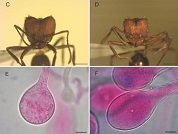Fungal symbionts of leaf-cutting ants of the genus Acromyrmex in dry forest of central Argentina
DOI:
https://doi.org/10.14522/darwiniana.2021.91.950Keywords:
Acromyrmex, Córdoba, gen 5.8S, ITS1, ITS2, LeucocoprinusAbstract
Fungi associated with leaf-cutter ants (LCAs) play a fundamental role in Neotropical ecosystems. The association with fungi allows LCAs to be the dominant herbivores and in this way influence ecological processes. In order to know the taxonomic diversity of fungal symbionts associated with LCAs, ten sampling sites were selected corresponding to the Chaqueño Serrano district and the Algarrobo district. Samples of fungi grown by leaf cutter ants were collected, a part of the fungal material was grown in potato agar culture medium with dextrose and another was stored in a CTAB buffer. Subsequently, amplifications of the ITS1, ITS2 and 5.8S ribosomal gene were carried out. A phylogenetic analysis (Maximum Likelihood and Bayesian) was performed with the sequences. Results show that the leaf cutter ants in the sampled region cultivate symbiotic fungi of two well-differentiated phylogenetic clades (known as A and B). The agar cultures showed a slow growth, with development of globose structures named gongylidia that are grouped together forming staphyla (clusters). Among the ants studied, Acromyrmex striatus is associated with fungi from both clades. In the Espinal forest (Algarrobo district) A. striatus was found associated with clade B fungi (Leucocoprinus sp.) and in the Chaco Serrano (Chaqueño Serrano district) with clade A fungi (Leucocoprinus gongylophorus). While Acromyrmex crassispinus and A. heyeri included in the study exclusively cultivate L. gongylophorus from clade A fungi regardless of the region they inhabit. In addition, the first molecular identification of the fungus L. gongylophorus cultivated by Acromyrmex silvestrii is reported.

Downloads
Published
How to Cite
Issue
Section
License

Starting on 2012, Darwiniana Nueva Serie uses Licencia Creative Commons Atribución-NoComercial 2.5 Argentina .





